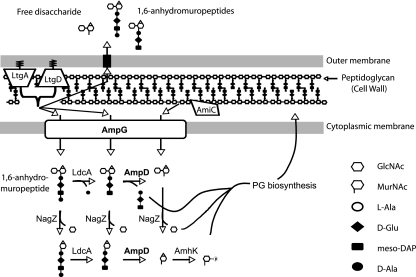FIG. 1.
Model of peptidoglycan recycling in Neisseria gonorrhoeae. As the bacterial cell grows and divides, the sacculus is remodeled by peptidoglycanases including lytic transglycosylases LtgA and LtgD and amidase AmiC. The liberated PG fragments include 1,6-anhydro PG monomers and free disaccharide. The gonococcal genome was found to encode homologues of multiple PG recycling proteins, and their predicted functions are shown here. PG fragments are taken into the cytoplasm through the AmpG permease to be further degraded by a carboxypeptidase (LdcA), an N-acetylmuramyl-l-alanine amidase (AmpD), and an N-acetylglucosaminidase (NagZ). The order in which these reactions occur in gonococci is not known. The resulting tripeptide is incorporated within the PG biosynthetic pathway leading to UDP-pentapeptide monomers for incorporation into the growing sacculus. The symbols used to represent amino acids and sugar residues were chosen to mirror those used by Jacobs et al. (27).

